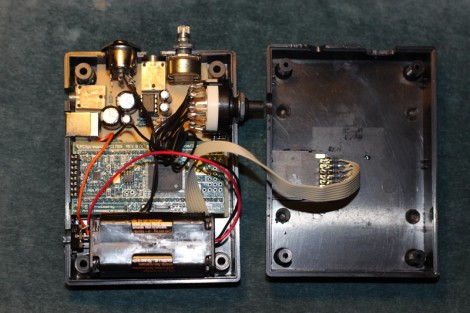
This portable sample player packs quite a punch. [Lee] wanted a nice portable way to take his samples with him, but refused to water-down the features just because it is portable. He set of goal of playing between 3-8 simultaneous notes from a large assortment of stored samples.
Sample space was the first design consideration, and it’s hard to beat the price per megabyte of an SD card. After some calculations he concluded that it is possible to pull these samples off the card quickly enough to achieve his simultaneous note goal at CD quality frequencies, but only if there is little or no latency when reading from the card. This means [Lee] needed a fast processor so he chose the LPC1769 which is an ARM Cortex-M3 processor which can run at 120 MHz.
The project box includes room for a volume knob to control the output from the in-build headphone amplifier. There’s also a rotary encoder for selecting sample sets. But we’re a bit confused on this part as the device is MIDI controlled. [Lee] is the creator of the electronic Moolodeon, which itself has MIDI out and will be used as a controller for this project.














It’s MIDI-controlled in that it plays notes sent to it by other MIDI devices (e.g., a keyboard).
The rotary encoder allows you to change the type of sound (such as a bass or guitar) that’s played when it receives those MIDI notes.
That’s exactly whay I was thinking. He must be a guitar player as this setup would easily allow him to play multiple samples of chords without them drowning each other out.
I’m not sure what you mean – that new chords would cut off the previous ones?
This sample player can play a maximum of 8 notes at one time, regardless of the sound selected. And I assume (haven’t rechecked the article) that switching sounds will cut off any currently playing notes.
Wave samples or licks.
To call it a player implies licks, if wave samples it is a synth or sampler and the musician is the player.
“Sample player” is a pretty common term for a synth that plays prerecorded samples, like this one does.
Hi guys,
Really simple explanation on the rotary switch: The sample player allows bank switching via MIDI program change (as per any “proper” player), but my moolodeon controller doesn’t have any buttons for sending those commands. To make up the shortfall I put a rotary switch on the player as a quick hack…
Check out this guy who recreated my project (with more blinkenlights and perspex): http://www.youtube.com/watch?v=KgCKO7A0IEs
Thanks Lee. Does it keep sounding playing tones when you switch banks? I don’t recall seeing either way in the article, forgive me if I missed it.
Hi, no it switches entirely between diffent sets of samples.
Example: Bank 1 selected – you’re playing a set of synth leads sounds, you then turn the knob and Bank 2 is selected – you’re then playing a pipeorgan sound set with all the notes that may have been sounding previously having been muted.
It’s just the sample operation sending a MIDI program change to select the sound bank.
When the bank change happens, internally the player stops all sound output for about a second while it reads all the required samples for the sample bank, and then reads all the SD card sector positions for each of the samples in the set…